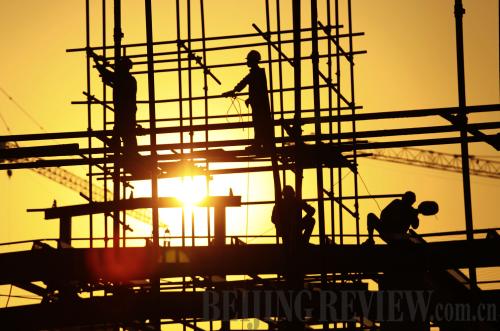|
 |
|
BUILDING THE ECONOMY: Workers construct a building in Jiujiang, Jiangxi Province (ZHANG HAIYAN) |
The National Bureau of Statistics (NBS) said on January 20 that in 2013, China's GDP grew 7.7 percent to 56 trillion yuan ($9.17 trillion), reaching the goal of 7.5 percent set by the Central Government at the beginning of the year. In short, the Chinese economy has continued to grow at a relatively quick pace.
Such a growth rate represents a hard-earned achievement. In 2013, the Chinese Government intensified economic restructuring, and the massive shutdown of outdated production capacity with high-pollution and high-energy consumption levels might well have caused economic downturn. But to guarantee an increase in the employment rate and improve people's standard of living, the Chinese Government had to ensure the economy developed stably. This seemingly paradoxical situation made the prognosis for economic growth rather pessimistic. However, the figures for 2013 showed that the Chinese Government has managed to balance economic transformation and growth.
Ma Jiantang, head of the NBS, said that faced with increasingly complicated and severe external and internal conditions, China has firmly deepened its reform and opening up and implemented innovative macro-control measures using a scientific approach. According to him, the overall national economic performance in 2013 showed a good momentum of stable and moderate growth.
However, he also claimed that some preexisting problems, such as serious surplus capacity and potential risks in the banking sector, have not been alleviated and these have had adverse impacts on the economy. These are problems China will have to deal with in its future economic development.
Up from the bottom
China's economic growth first slowed down and then resumed in 2013. According to the NBS figures, in the first two quarters of 2013, economic growth dropped, and began to rise again in the third quarter.
Liu Yingqiu, a researcher with the Chinese Academy of Social Sciences (CASS), thought that sluggish demand in the domestic and foreign markets and economic restructuring are the main reasons for the fluctuations in economic growth.
To ensure economic growth in 2013, the Central Government continued its policy of making appropriate adjustments in accordance with the economic situation. It launched several reform measures such as reducing items subject to administrative approval, initiating interest rate liberalization, accelerating the development of energy-saving and environmental protection industries, supporting micro- and small enterprises in financing, encouraging spending in the information industries, reforming the railway investment and financing mechanism, and establishing the Shanghai Pilot Free Trade Zone.
These measures successfully reversed the downturn of economic growth during the first two quarters, ensuring that the country beat its target for economic growth for the whole year.
Ma said the Chinese economy had the characteristics of being "stable, progressive and good" in 2013. The overall economic performance, employment and prices were kept stable; economic restructuring made positive progress with industrial structure being optimized, demand structure improved, regional development was better balanced, income became more equally distributed, and the quality of economic growth and people's standard of living both took a turn for the better. These achievements indicated that the reform measures have been timely and effective.
Wang Yong, an analyst with CITIC Securities Co. Ltd., said two areas were paramount in 2013: CPI and employment. The Central Government's target for CPI at the beginning of 2013 was below 3.5 percent, while the final result was 2.6 percent.
Wang said owing to the effects of the U.S. quantitative easing policy, the whole world has been suffering from rising inflation, especially the emerging market nations. The inflationary rates in Brazil, Russia and India stood at 5 percent, 6 percent and 9 percent respectively at the end of 2013. Hence the fact that China managed to keep its inflationary rate down at 2.6 percent represents a remarkable achievement.
The other important area was employment. In 2013, China created more than 11 million new jobs, surpassing its target of 9 million at the beginning of the year.
According to a report released by the National Academy of Economic Strategy under the CASS, as a result of the economic reform and development that took place in 2013, China's disequilibrium in economic structure has been balanced. The report says China's imbalance index of economic structure dropped from 0.63 in 2011 to 0.49 currently.
The report holds that from 2013, the Chinese economy changed from "high growth" to "secondary high growth," and such "secondary high growth" will continue for three reasons. Firstly, rising costs in the service sector will increase the sector's contribution to the economy, but because of low productivity, the service sector will be unable to help maintain a high speed of development. Therefore, the rising contribution of the service sector will slow down overall economic growth to some extent.
Secondly, the reduction of surplus capacity relies on the realization of plans for industrial upgrading and economic transformation, and economic restructuring is expected to continue for a long time. It will take at least three to five years for China to solve the problem of overcapacity.
Thirdly, upsurge in market demand will gradually drop as globalization, urbanization and heavy industrialization will no longer progress simultaneously.
| 